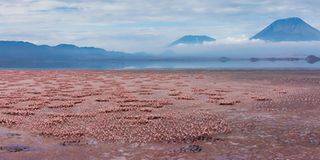Prime
Lake Natron: Myths, flamingos and hidden tourism treasures

Flamingos at Lake Natron with volcanic Oldoinyo Lengai in the background. PHOTO | FILE
What you need to know:
- While many animals meet their demise, thousands of flamingos thrive at this lake.
Some of the most outlandish myths being spread across the internet are that Lake Natron, located in northern Tanzania in Ngorongoro District, can turn animals into stone.
A quick dive into YouTube videos, and you will encounter all the clickbait videos branding Lake Natron as one of the most dangerous lakes in the world. But what is the truth about this alkaline lake?
Transportation to Lake Natron from Arusha town is plentiful. Various tour companies would be glad to accommodate you.
A quick online search or a look at Tripadvisor would lead you to the right tour company to hire.
Visiting Lake Natron from Arusha city would take you four hours on a good day.
Located at the base of Mount Oldoinyo Lengai, the lake serves as the only known breeding ground for African lesser flamingos.
These pink-coloured flamingos are mainly found in sub-Saharan Africa and western India.
The drive to Lake Natron is long but scenic; the distance has helped preserve the environment from frequent tourist visits.
As you approach the lake, you will pass by the awe-inspiring Great Rift Valley, which cuts through Tanzania, extending from the Middle East down through East Africa.
Upon arriving at the lake, luxurious, warm accommodation is available in the form of tented camps.
A convenient place to have a hot cup of coffee could come in handy after a long 4-hour drive.
A Maasai tour guide is recommended to help you navigate your way around the lake, as vehicles must eventually park, and the remainder of the tour is completed on foot.
The lake is always deserted but comes to life from August to October when the pink flamingos converge to breed.
This lake scarcely supports life due to its extreme alkalinity, with a pH level exceeding 12.
However, it is precisely these harsh conditions that allow salt-loving microorganisms to thrive, flourishing in an environment that is inhospitable to most other forms of life. Flamingos feed on these algae and microorganisms.
During the dry season, the lake displays striking hues of red and pink, enhancing the mysterious allure of Lake Natron.
The high rate of evaporation results in elevated salinity levels, creating an environment that is inhospitable to most forms of life.
Many animals have tragically succumbed to the water, often perishing in their desperate quest to quench their thirst.
This phenomenon has given rise to the ancient myth of animals turning to stone, a tale as timeless as the lake itself.
The Maasai people who live around the lake hold a belief that it is sacred, with stories circulating about individuals turning to stone upon falling into its waters.
Scientific studies have confirmed that Lake Natron’s water, which does not flow anywhere, becomes a concentration of all the salts from the rainwater it receives.
This unique chemical composition is responsible for the calcification of animals that enter the lake.
The lake’s proximity to the active volcano, Mount Oldoinyo Lengai, contributes to its high alkaline levels.
The volcano frequently spills lava rich in nitrogen into the lake, resulting in a unique environment that can cause the bodies of animals that enter the water to calcify, leading to the assumption that they have turned to stone.
The victims of this calcification extend beyond just animals in desperate search of water; birds, too, often fall prey to the deceptive mirror-like surface of the lake.
Lured by the illusion, they dive in hopes of catching fish, only to find themselves submerged and at the mercy of the harsh alkaline waters.
While many animals meet their demise, thousands of flamingos thrive at this lake.
Their resilient skin and scaly legs shield their bodies and bones from burns, enabling them to flourish in this harsh environment.
With their beaks dipped into the very waters that are lethal to other creatures, these remarkable birds feed on the microorganisms that abound there.
The scene of the flamingos flying in uniform like synchronised swimmers and settling in this body of water and painting the lake pink is a magnificent view for any visitor who has endured hours on the road to make it to this mysterious lake.
Depending on the time of the year, this water is not safe for humans to swim, with high temperatures reaching 60 degrees Celsius, which can cause 3rd degree burns on a human body.
For those who seek to cool their bodies in water, it is advised that one take a short hike to Nagre Sero waterfall.
The Ngare Sero Waterfall, which feeds into Lake Natron, is located 20 kilometres away and offers picturesque scenery along the way.
Reaching the waterfall requires at least an hour’s uphill hike, but despite the remoteness and wilderness of the area, it is relatively safe with no wild animals posing a threat.
As you embark on this journey, be prepared to get your feet wet and, at times, navigate through knee-deep water pools leading you to the breathtaking waterfall.
Upon arrival, your gaze will be drawn to the majestic rocky cliffs, which stand proudly amidst lush greenery—a striking contrast to the arid landscape that lies just a stone’s throw away.
Here, you will also discover a natural swimming pool, inviting and safe for diving, offering a perfect respite from your trek.
This is where most visitors just strip to their shorts and stand below the waterfall, letting the cold water run down their faces to wash away the sweat from the hike.
Ngare Sero is a serene gem, often overlooked by tourists, preserving its unspoiled natural beauty.
This captivating waterfall beautifully complements a visit to Lake Natron, allowing visitors to experience two distinctive attractions in one remarkable area.




